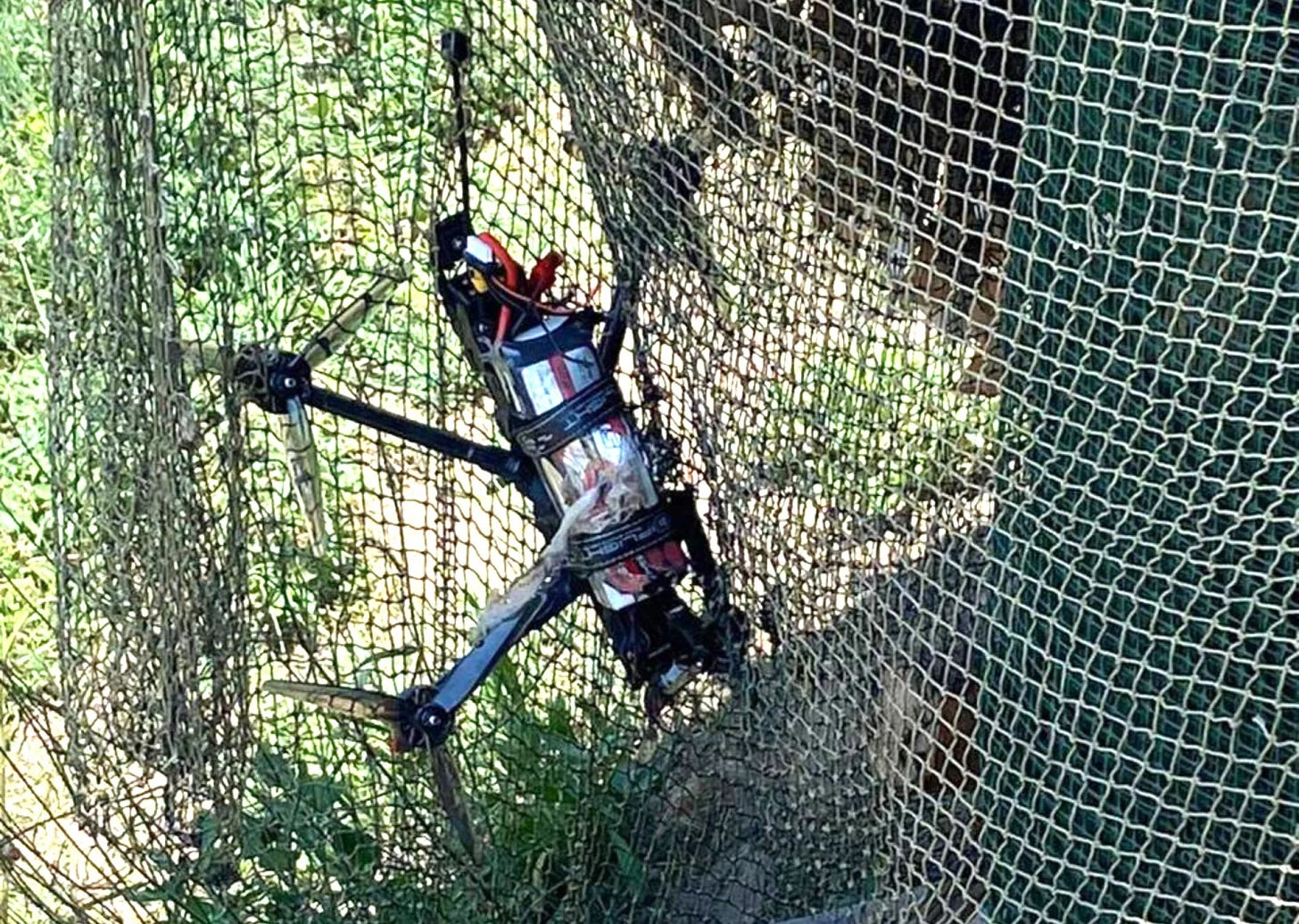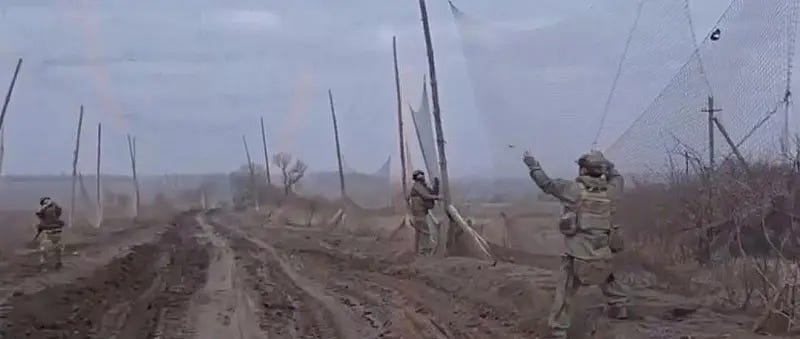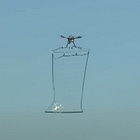Using Fishing Nets as Anti-Drone Armor
How to use nets to protect roads and buildings from drone attack.
We have previously written about weapons that launch nets at drones—tangling their propellers and causing them to crash.
But what if we did the opposite?
Instead of covering enemy drones with nets, what if we covered our roads and buildings with anti-drone nets?
Both sides of the 2022 Russia-Ukraine War have experimented with industrial fishing nets as defensive armor. Here is what we have learned from them.
Why fishing nets work

Nearly all quadcopters have propellers that are 75 millimeters or larger1.
Commercial fishing nets typically have a mesh size of 50 millimeters2—small enough to entangle nearly all drone propellers and prevent bombs from reaching their target.

Types of defensive nets
1. Net tunnels for roads
Soldiers driving a tank or a jeep on an open road are particularly vulnerable to drone attacks.

In 2023, Russian forces were first spotted setting up isolated nets to protect their routes in eastern Ukraine—sometimes hanging them between lamp posts along a road.
By 2025, the Russians were spotted setting up continuous net tunnels—designed to protect a stretch of road without gaps.
In early 2025, observers noticed the Ukrainian military deploying similar protective tunnels3.
2. Nets for buildings
In early 2025, the Belgorod Oblast in Russia experimented with covering apartment buildings in anti-drone nets. Russian media published the following video4 showing the buildings covered in nets. Advantages of nets
Relative to a more complex air defense system, a net is brilliantly simple:
No export controls. Fishing nets are not restricted like other air defense hardware.
Plentiful supply. Industrial fishing nets discarded after years of use can be recycled into anti-drone nets5.
Low hardware cost. A used fishing net could cost as low as $250 per metric ton—enough to cover anywhere from 1,600 to 3,200 square meters6.
Passive operation. A net does not require ammunition, electrical power, or a human operator to continually protect an area7.
Nets have additional advantages when compared to chain-link fences, razor wire, and other metal barriers:
Minimal radar signature. Nylon or polyethylene nets are difficult to see on radar8. In contrast, a metal chain-link fence might offer more protection, but the metal will be far more visible to enemy radar9.
Preventing bombs from exploding. A kamikaze drone will explode if it hits a chain-link fence. But drones caught in a fishing net may become entangled without immediately detonating.
Disadvantages of nets
As of May 2025, infrastructure-protecting nets are still a new development. Nets have several limitations that make their overall value uncertain:
Unclear effectiveness. Ukraine claims to have successfully launched drone attacks against targets inside Russian net tunnels. Nets likely offer only minimal protection against fragmentation bombs—which detonate into small pieces that can pass through the net.
Labor-intensive installation. Installing a net tunnel requires driving countless fence posts into the ground. Covering a building in a net may require scarce construction cranes.
Weather damage. Rain, snow, and ice can cause nets to snag or snap. Nets also degrade through continual exposure to ultraviolet light from the Sun.
Ongoing repair costs. In addition to weather repair, nets must be repaired after drones attack them10. Repairing a single net is easy, but it is challenging to repair thousands of miles of nets can before the enemy can exploit the holes.
Potentially trapping people inside. If a convoy of vehicles are driving through a net tunnel, they could be trapped inside if the first and last vehicles are disabled11.
Conclusion
As of May 2025, the value of nets protecting roads and buildings is still unclear for two reasons:
Total Cost of Ownership (TCO). Nets are cheap to buy… but as other methods of drone defense become cheaper, the cost of installing and repairing thousands of miles of nets may become unfavorable.
Effectiveness over time. Drone technology gets better over time, but used fishing nets don’t. Newer drones, explosives, and incendiary weapons may cut through today’s nets like a knife through butter.
We will see what these nets are made of in the coming months.
Further reading
Small high-performance racing drones commonly have 3-inch propellers (76.2 mm), which is too big to sneak through a single 50-millimeter mesh hole. Other FPV drones (used in both military and civilian contexts) commonly have 5-inch propellers or larger.
A 50-millimeter mesh is large enough that the smallest toy drones might be able to get through the mesh. Shrinking the mesh size would increase the weight of the net with little benefit. However, as of May 2025, such toy drones are too small to carry a significant explosive payload. It is possible that this may change in the future.
As of May 2025, the exact locations of these Ukrainian net tunnels have not been disclosed for operational security reasons.
The Ukrainian publication Pravda re-published this video clip from Russian state media. This Russian newspaper article offers more detail about the Belgorod project.
Carl Futtrup, a Danish volunteer, partnered with various organizations to send several hundred metric tons of discarded industrial fishing nets to Ukraine to be repurposed as anti-drone nets. Most of these nets became useless to Danish fishermen when the United Kingdom withdrew from the European Union and banned them from fishing in British territorial waters.
Here are some very loose calculations I made from the prices of fishing nets I found online in May 2025:
Depending on density, a metric ton of heavy trawl-grade fishing net could cover anywhere from 1,600 to 3,200 square meters.
New bulk fishing nets from nylon or similar materials cost about $2,750 USD per metric ton.
Used bulk fishing nets are available as low as $250 USD per metric ton.
In comparison, a metal chain link fence can cost as low as $0.60 USD per square meter when purchased in bulk. Then, 3,500 square meters of chain link fence costs $1,920 USD. This is somewhat cheaper than a new net, but is anywhere from 3.8 to 7.6 times the cost of a used net.
Of course, used fishing nets that have been donated are basically free. See the above footnote about Carl Futtrup.
We define operations to exclude repair costs, which we address directly in the Disadvantages section.
Nylon and polyethylene both have a dielectric constant below 3 and a loss tangent below 0.01, which makes them ideal for building barriers that are transparent to radar. The mesh strands may only be a few millimeters thick, which may be significantly smaller than the wavelength of an enemy radar unit.
The radar signature of your armor only matters if you are protecting an object whose radar signature is already minimal. Your enemy likely already knows where your buildings and roads are. Such infrastructure either appears on radar, or your enemy does not need radar to find it.
Even after a drone caught in a net explodes, the net may still be useful. Mykhaylo Ardashyn of Ukraine's National Guard told Business Insider that “even after an explosion, the net will not be destroyed or burned completely, and some fibers can still catch other drones."
Robert Brovdi, founder of the Ukrainian military drone unit Madyar’s Birds, described this convoy scenario to Counteroffensive.Pro in early 2025.



